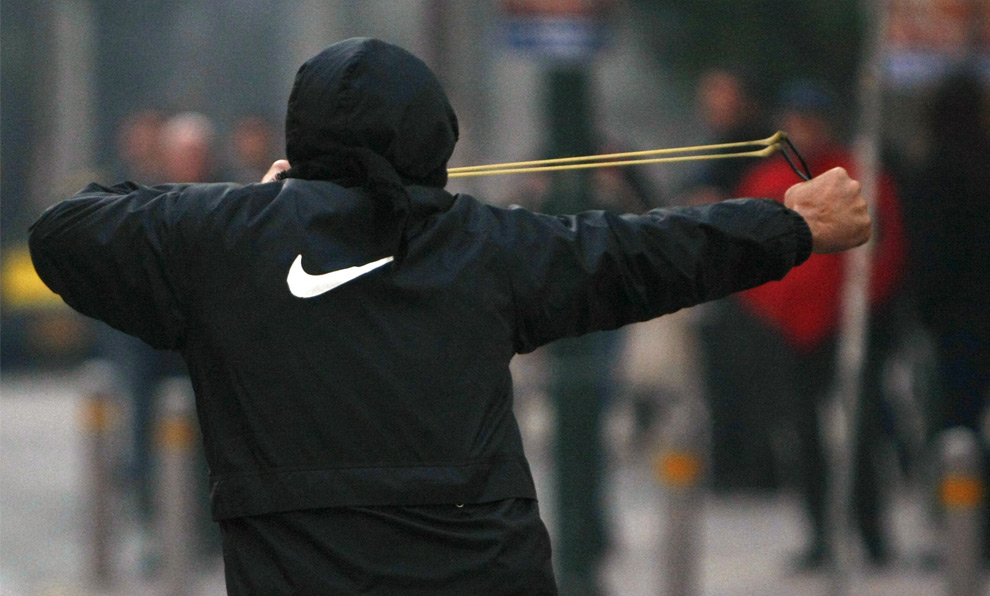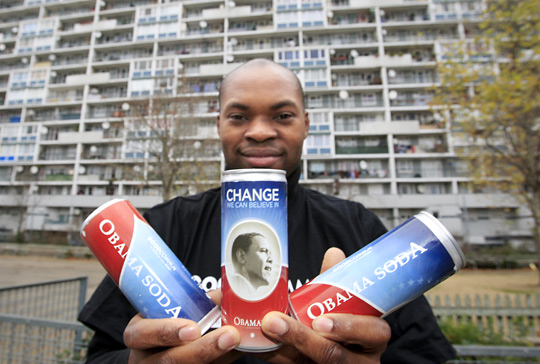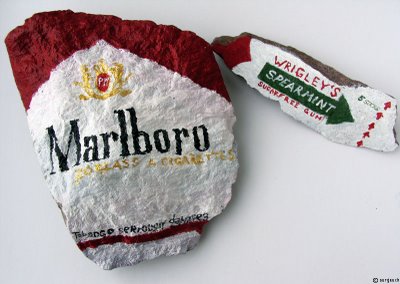Someone who I met once a few years ago, sends (via what I assume is a blast email to many people, so maybe it’s gotten around already) this.
It encourages you to forgive — you can forgive George Bush, or anyone of your choosing, or both. Here is what results.
I kind of like it. And I certainly like the spirit of it quite a bit.
(The sender works at an agency, or did when I met him, but I think — I hope — this is not related to any branding campaign.)
 CARD TRICKS:
CARD TRICKS:
The latest spin on the most transactional form of holiday giving.
This week in Consumed:
The nature and meaning of the gift has been mulled by philosophers, anthropologists and economists for many decades. The thinking on gift cards is less extensive but has its place in that history. To the believer in the idea of gift-giving as a practice that binds individuals, and indeed societies, a store-specific piece of plastic preloaded with $50 is an offensively thoughtless dodge. To the believer in marketplace solutions to the problem of well-meaning but misguided givers, it’s a triumph of efficiency. Gift-card sales are expected to suffer this year on widely publicized fears that they’ll be rendered worthless by failing retailers. But that has overshadowed the more surprising development in the nature of the form: the introduction of gift cards with functionality….
Who gets the real payoff from this development? Read the column in the December 21, 2008, issue of The New York Times Magazine, or here.
Consumed archive is here, and FAQ is here. Consumed Facebook page is here.
“Letters should be addressed to Letters to the Editor, Magazine, The New York Times, 620 Eighth Avenue, 6th Floor, New York, N.Y. 10018. The e-mail address is magazine@nytimes.com. All letters should include the writer’s name, address and daytime telephone number. We are unable to acknowledge or return unpublished letters. Letters may be edited for length and clarity.”
Posted Under:
Consumed
This post was written by Rob Walker on December 20, 2008
Comments Off on In The New York Times Magazine: Functional gift cards
 Interstate Bakeries, maker of Wonder Bread and Twinkies, was ahead of the curve on the bankruptcy trend, going chapter 11 four years ago, way before it was cool. And earlier this month, again bucking the zeitgeist, the company emerged from bankruptcy! NPR assesses its chances of longterm viability here. September 17, 2006 Consumed about Wonder Bread’s promient role in Talladega Nights is here.
Interstate Bakeries, maker of Wonder Bread and Twinkies, was ahead of the curve on the bankruptcy trend, going chapter 11 four years ago, way before it was cool. And earlier this month, again bucking the zeitgeist, the company emerged from bankruptcy! NPR assesses its chances of longterm viability here. September 17, 2006 Consumed about Wonder Bread’s promient role in Talladega Nights is here.
By way of being interviewed by box vox, I learned of the existence of Method Lust, a blog all about Method cleaning products. (Obviously it’s very pro the brand.) Method comes up a couple of times in Buying In, and was the subject of this February 29, 2004 Consumed. I’m also adding Method Lust to the Blogging The Brand section of the linkroll at right.
NYT had the latest private-labels-and-the-recession article (also picked up by PSFK). Wrapup of Consumed columns on private labels, with context, here.
Photojojo offers resources to those morning the death of Polaroid. March 16, 2008 Consumed on Polaroid here.
Makezine on Moleskine modification. June 26, 2005 Consumed on Moleskines — featuring the ultimate resource on the subject, Moleskinerie — is here.
Edward Winkleman, a gallerist and thoughtful of observer of the art business interviewed for this August 3, 2008 Consumed about KAWS, announces his forthcoming book, How To Start And Run a Commercial Gallery.
Posted Under:
Update
This post was written by Rob Walker on December 19, 2008
Comments (0)

From Boston Globe’s Big Picture: “A protester prepares to launch a stone with a slingshot at policemen during riots in Athens December 10, 2008.”
Full Greek Riots Gallery here.
Thx: JKD!
I’ve just belatedly read a bit in Ad Age declaring the importance of values such as sustainability and social responsibility in the year ahead, and offering various resolutions for 2009 to its readership of commercial persuasion pros. Number 3 is:
Pick a local, entrepreneurial company that has a business model with social or envieronmental responsibility at its core, and go and work for them — pro-bono if there’s no other way.
That strikes me as pretty lame and unimaginative.
Why? Because the basic paradigm offered is that all agencies do is “go and work for” somebody. They don’t have their own ideas, they don’t have their own beliefs. They’re willing to “work for” someone who stands for something — but they themselves stand for nothing. And are (or so this “resolution” suggests) essentially incapable of standing for anything.
So I would say a better resolution might be:
Pick an idea that you believe in — with social or environmental responsibility at its core.
Now go out there and use your persuasion talents to advance that idea in the public sphere. Change behavior in ways that do not involve buying your clients’ stuff, that do not involve the profit motive at all.
Do it because you — yes, you; not an entrepreneur or a brand that you work for; you — actually believe in something, and you stand for something, and you have ideas, and you care.
Don’t look for a client, pro bono or otherwise, who has values. Just have values.
In fact, I hereby issue the Murketing Challenge to all commercial persuasion pros (in advertising, marketing, PR, “ideation,” whatever) for 2009: If you do a project like this, of any kind, something where you, the commercial persuader, or your agency, does work to advance an idea that you believe in, tell me about it and I will happily publicize it here. And if anybody really does anything, maybe I’ll even give out a prize. (If so I would base it on the reactions of Murketing.com readers, etc., not just my personal reaction.)
This is not work on behalf of a client of any kind — company, nonprofit, politician, political group, or charity — it’s work on behalf of you, and something you believe in.
It can be as big as unconsumption, and as small as making a positive change in the neighborhood where you are based.
If you like this idea, then spread this post, and tell me what you come up with at murketing@robwalker.net.
If you don’t like this idea, then don’t.
And that concludes the 48-Hour T-shirt Project, proudly sponsored by The Murketing Organization and Buying In.
Thanks to all who patronized, who linked, who told a friend. (If you’re interested in hearing should I launch a sequel of some kind, sign up here. And check your junk/spam folder for the double-opt-in.)
Even bigger thanks to the designers: Derek Black, Greg Eckler, and Angie Smith. Y’all were fantastic. Here are all three designs in one place. Click each shirt for an explanation of the research that inspired it.




Obama Soda, available in France — proof that the French really do know the meaning of the word entrepreneur (as the old joke goes). NPR story here.
So here’s an interesting exercise in attempting to reposition the symbolism of an unexpected incident.
Bush is over in Iraq, and a guy gets up and hurls his shoes at the president’s face, as hard as he can. Then he does it again. Bad PR moment!
But no. Bush says, “That’s what people do in a free society, draw attention to themselves.”
Condoleeza Rice says the incident “is a kind of sign of the freedom that people feel in Iraq.”
Excuse me? Do we enjoy our democracy by hurling objects at each other’s heads here in the Land of the Free? I’m pretty sure that if you go out and throw a shoe, or any similar item, at someone’s face, you’re going to be arrested. As well you should be! Throwing a shoe at someone’s face, even in America (even in your own home, for that matter) is not a sign of freedom, and it is not “what people do” in any free society. It’s attempted assault.
As for what happens when people like the show-thrower “draw attention to themselves” and how much it’s a “sign of freedom,” I think it’s worth considering the NYT’s deadpan description of what was happening while Bush riffed on the positive symbolism of the moment: Once the shoe-thrower was tackled and taken away by security, the President spun the incident away — “as the man’s screaming could be heard outside.”
Points for trying, though. I didn’t think there would be a way to reposition a guy throwing shoes at the President’s face as a victory for the American idea. But I guess there is.
Also, points to GWB for agility: He looked quite spry as he ducked that first shoe in particular. Here’s BoingBoing’s roundup of amusing GIF reactions — which is how we really express our freedoms in the home of the brave these days.
You’ve read about the 48-Hour T-Shirt in Core77, PSFK, Design Observer, Coolhunting, Coudal, or We Are The Market. And now…

The third 48-Hour T-Shirt is now no longer available. That’s the design, above: White on a red American Apparel 4.3-ounce fine cotton athletic fit T.
I can’t name a favorite design from this project, since I loved them all, but since I came up with the ideas that inspired the designers, I think I’m allowed to say which one was, in my opinion, my best idea, and it’s this one:
Veladone-Rx is a made-up drug name used in an experiment about pricing and the placebo effect. You already know I have a thing for imaginary brands, so I’m particularly excited to offer you the opportunity to advertise this non-existent product drawn directly from — of all places — the world of behavioral psychology studies.
A summary of the research inspiring the design, below, is also available in PDF form, here.
This fictional pain-killing drug was part of an experiment conducted by Dan Ariely — the behavioral economics expert and the author of Predictably Irrational — and colleagues.
Subjects read a brochure explaining what a great painkiller Veladone is, and that it cost $2.50 a pill. After a dose, almost all subjects experienced less pain (from electric shocks). In reality, Veladone was merely Vitamin C. Here, then, was the placebo effect in action.
Then the experiment was repeated – this time a group of subjects were told that Veladone cost just 10 cents a pill. Under that circumstance, the result was much less impressive: Only about half the subjects experienced pain relief.
The moral, evidently, is that we get what we pay for – even when we’re just paying for a placebo.
Design by Angie Smith, MFA student in advertising design at Savannah College of Art and Design.
The T-shirt Veladone-RX is available until 10 a.m. Eastern, Wednesday December 17. Time’s up! Direct inquiries about your order to the designer directly, at: anchaline@gmail.com.
The aim of The 48-Hour T-shirt Project is to prod consumers to think more about our own behavior, about how we can be manipulated, and about how we manipulate ourselves. Yes, doing this by way of products may be seen as either ironic, clever, or hypocritical. That’s (part of) the point.
* * *
 The 48-Hour T-Shirt Project is proudly sponsored by The Murketing Organization, and Buying In: The Secret Dialogue Between What We Buy and Who We Are, recently named one of the five top nonfiction books of 2008 by Salon; one of the 10 best business books of the year by Fast Company, and recommended by Core77 as one of its 77 gifts under $77.
The 48-Hour T-Shirt Project is proudly sponsored by The Murketing Organization, and Buying In: The Secret Dialogue Between What We Buy and Who We Are, recently named one of the five top nonfiction books of 2008 by Salon; one of the 10 best business books of the year by Fast Company, and recommended by Core77 as one of its 77 gifts under $77.
 TALK IS CHEAP
TALK IS CHEAP
Consumer spending finally falters — can it be good news?
This week in Consumed, as part of the Times Magazine‘s annual “Year In Ideas” issue, I look at the repackaging of falling consumer spending as frugality chic. Is this truly a sea change in values?
The truth is that we have long had mixed, even contradictory, feelings about consumption. A few years ago — pretty much at the height of our most recent nationwide spending binge — a nonprofit group called the Center for a New American Dream released a poll in which 81 percent of those surveyed agreed that Americans are “too focused on shopping and spending,” and 88 percent said our society is “too materialistic.” Not long after, the Pew Research Center surveyed Americans about various consumer goods we say we “can’t live without.” Between 1996 and 2006 the number of material necessities in our lives grew substantially. Aside from new entries — 49 percent can’t live without a cellphone, and 29 percent said the same of high-speed Internet access — our need for more familiar items spiked, too. The number of people who considered the microwave oven a necessity, for instance, nearly doubled. Some respondents added iPods and flat-screen TVs to the list. Uneasy as we may be about “materialistic” purchases, they remain a tangible proxy for progress.
Second thoughts about that paradigm are nothing new. “Too many of us now tend to worship self-indulgence and consumption,” Jimmy Carter declared in 1979 in his “crisis of confidence” speech. “We’ve discovered that owning things and consuming things does not satisfy our longing for meaning.” It’s hard to imagine anyone, then or now, arguing otherwise. But who, at the end of the 1970s, would have predicted the emergence of a new normal that included gas-guzzling S.U.V.’s and McMansions?
Read the whole column here, or in the December 14, 2008 issue of The New York Times Magazine.
Consumed archive is here, and FAQ is here. Consumed Facebook page is here.
“Letters should be addressed to Letters to the Editor, Magazine, The New York Times, 620 Eighth Avenue, 6th Floor, New York, N.Y. 10018. The e-mail address is magazine@nytimes.com. All letters should include the writer’s name, address and daytime telephone number. We are unable to acknowledge or return unpublished letters. Letters may be edited for length and clarity.”
Posted Under:
America,
Consumed,
The Trend Industry
This post was written by Rob Walker on December 13, 2008
Comments Off on In The New York Times Magazine: Deconstructing the “New Thrift”
Salon interviews Jessica Helfand on her Scrapbooks book here (via Scrap Smack). September 12, 2008 Consumed on scrapbooking then and now, here. April 4, 2004 Consumed on “Memory Maker” scrapbook-culture-inspired bracelets here.
Wow, I don’t know how I’m so late on this but I see that Nic Harcourt has left KCRW, where he was music director for ten years. Here’s a Consumed about KCRW’s online efforts, from January 23, 2005. Back in around 2003, I wrote about various KCRW DJs, including Harcourt, dabbling in the music-direction business, particularly for commercials, for a magazine that no longer exists. So no link on that.
 Animal says ESPO “created a line of yellow raincoats with imagery devised to represent a ‘metaphor for protection,’ many of which were reportedly ‘given to and worn by actual prostitutes’ as part of an exhibit the former vandal created for French fast crowd boutique Colette to highlight World Aids Day.” October 30, 2005 Consumed on ESPO (and yellow raincoats!) here.
Animal says ESPO “created a line of yellow raincoats with imagery devised to represent a ‘metaphor for protection,’ many of which were reportedly ‘given to and worn by actual prostitutes’ as part of an exhibit the former vandal created for French fast crowd boutique Colette to highlight World Aids Day.” October 30, 2005 Consumed on ESPO (and yellow raincoats!) here.
Coolhunting says Barackist art popular at Art Basel: “Throughout Miami, Mr. Obama was seemingly everywhere, as works featuring his likeness were given prominence by exhibitors.” Andrew Andrew posts an Obamart gallery of images they saw at the Miami art-a-thon. [ALSO: Looks like Giant Robot‘s next cover story is “Street Art + Obama.” Consumed on Obama as muse from April 13, 2008 is here.
CNN.com reports on Polaroid fans coping as the film disappears. (Via Design Observer.) March 18, 2008 Consumed on Polaroid’s journey from the mass to the fringe is here.
PSFK interviews Abe Burmeister about his Outlier cycling apparel brand (noted earlier), here.
Uniwatch impresario Paul Lukas’ ESPN.com column highlights the new No Mas “Finisher Bags” (picture here). Expansive Murketing.com Q&A with No Mas here and here.
Posted Under:
Update
This post was written by Rob Walker on December 12, 2008
Comments (0)
Via Commercial Alert, here is an article from Ad Age about something called “The Style Series, presented by Diet Coke.” Sounds like yet another example of “branded entertainment” — ho hum! — with the mild but lately run-of-the-mill twist that “the first event streamed live via the internet, outdoor electronic billboards and mobile phones.” Ooooh! Post-television! Whatever.
Anyway, here’s the thing that caught my attention: The debut episode includes “the exclusive premiere of Rihanna’s new e-film for Gucci.”
So, let’s just get this straight. One of the featured guests on the branded entertainment post-TV program was there to tell us about her latest post-TV branded-entertainment deal?
Maybe there’s a clue in here of what Leno’s new show ought to be, or what the future of talk shows in general might look like: How about a branded show that is exclusively devoted to the touting and discussion of the latest exciting new developments in branded entertainment? Instead of stars flacking their new movies, they’ll simply discuss their latest endorsements. Indie directors will premiere the latest commercial work they’re doing to pay the bills. Reality-show stars will talk about products placed in whatever series has made them “famous.” And so on.
Very exciting to live in the “post-advertising era,” no?




 "
"
 CARD TRICKS:
CARD TRICKS:





















 Kim Fellner's book
Kim Fellner's book  A
A